
Playing Possum with Pseudopanax
May, 2022
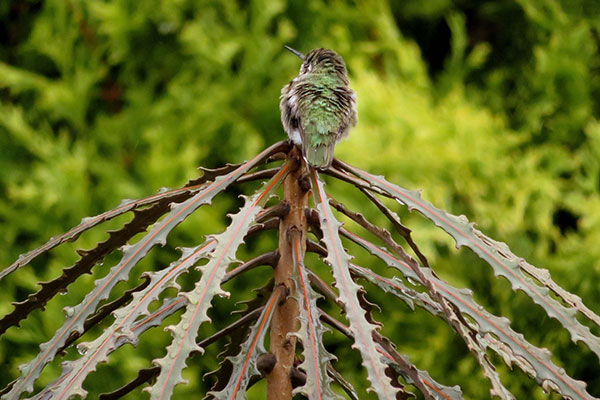
Is it dead or alive? This existential question resonates with adventurous gardeners come springtime as we tally winter’s casualties when inspecting our botanical treasures. Some plants, however, elicit similar doubts all year long, even when in the pink of health. This Addams Family aesthetic, probably an evolutionary adaptation to avoid being munched on by large herbivores, is usually transient, a passing phase of youth before the plants —generally shrubs or trees— settle into stolid adulthood. Curiously, many of these moribund-looking bundles of twigs are natives of New Zealand.
One of the weirdest is Dacrycarpus dacrydiodes, a conifer with tiny, flattened, bronze-tinted juvenile foliage that I nurtured in a container as an “everdead” plant for a decade before it actually gave up the ghost. Other examples include various species of Pittosporum, Muehlenbeckia, Corokia and Sophora. Portland’s own Loree Bohl featured several of these morose masqueraders in her Danger Garden blog a few years ago. I think Loree and I would agree that the most bewitching of this gothic group are a pair of lancewoods, Pseudopanax crassifolius and P. ferox. Let’s delve into this duo.
First, a bit of etymology: Although “Pseudopanax” means “false ginseng1,” they are in fact related members of the Aralia family along with the more familiar Hedera (ivy) and Fatsia, as well as the Taiwanese giant Tetrapanax and our native Oplopanax (devil’s club). The two specific epithets are spot-on descriptions of the leathery foliage: crassifolius means “thick-leaved” and ferox is Latin for “fierce”. Their rigid, downward pointing leaves in the juvenile stage, which lasts 15 to 20 years, measure about two feet long by less than one inch wide and bear a striking resemblance to a hacksaw blade.
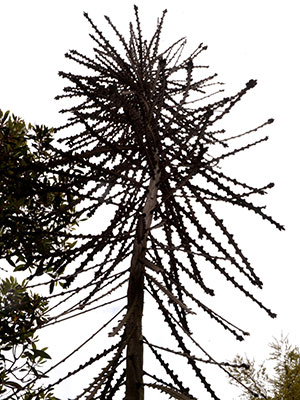
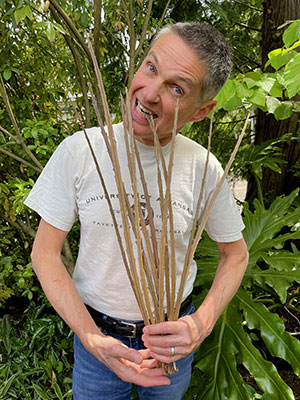
Why did this formidable pair develop such antisocial adolescent attitude? Among the more captivating theories is that they evolved this defense to escape predation by moas, the giant (now extinct) flightless birds whose beaks could reach leaves more than 12 feet in the air. When Pseudopanax trees eventually grow above this height, the solitary trunk begins to branch and the foliage transitions to much shorter, softer, “normal” looking evergreen leaves. Here’s where things get even more interesting: P. crassifolius holds the title for the botanical world’s most extreme case of leaf heteroblasty, that is, markedly different foliar forms over the course of a plant’s life. Many of us are familiar with the contrast between juvenile and adult leaves in eucalyptus and ivy, but that’s just two stages. P. crassifolius boasts four distinct stages and even more steps: Seedling-stage leaves go through five steps prior to the dramatic juvenile stage, followed by a transitional stage and finally the more sedate adult form.
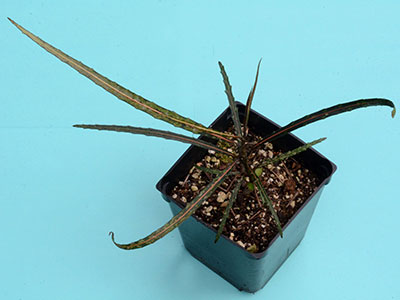
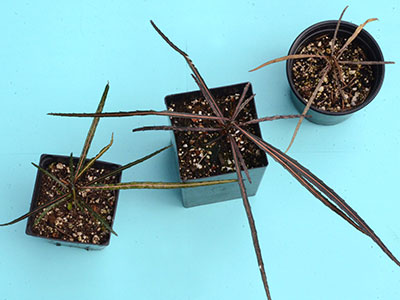
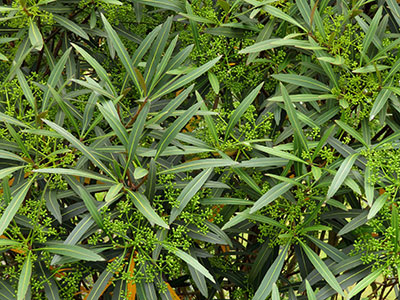
By now many of us have seen, if not grown, the juvenile forms of these fascinating species but barring a trip to New Zealand few have witnessed their transition to adulthood. I’m pleased to reveal that my 20-year-old, 24-foot tall P. crassifolius matured a few years ago and is producing fertile seed. Yes, I’m now the proud surrogate papa of a few dozen bizarrely mottled 14-month-old seedlings. Unexplained is how this immaculate conception occurred, as Pseudopanax is supposed to be dioecious, meaning separate male and female plants, which in theory requires at least two mature specimens to produce fertile seed. I have only one P. crassifolius. Hmmm.
There are further mysteries surrounding Pseudopanax, one of which is wildly varying growth rates. About 12 years ago I obtained three seemingly identical P. ferox seedlings in 4-inch pots. They were a couple of years old and about six inches tall. Having been told their cold hardiness increases with age, I waited three years before planting two of them in the ground. There they thrived and began to shoot skyward: One now measures 14 feet and is the favorite perch of our dominant, resident hummingbird. The other has reached the 10-foot mark. The third, which I kept for safekeeping in a stoneware pot, stopped growing several years ago at only four feet. Was it sulking, upset that its siblings were free to stretch their roots while it was confined to a container? Seeking appeasement, I planted it out a couple of years ago, but the petulant piker still hasn’t grown a millimeter.
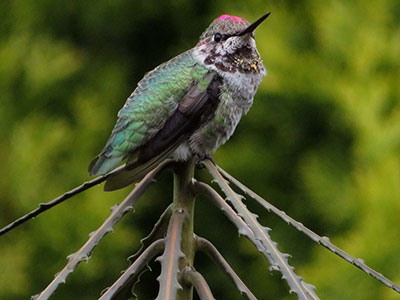
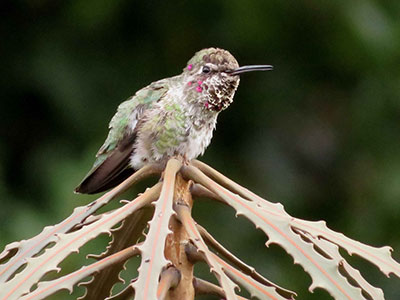
Playing possum is another of their distinctive traits. In addition to the suspended animation case mentioned above, my oldest specimen of P. ferox, procured in 2005, is also the oddest. Seeking to protect it, I planted it on a sheltered, well-draining slope close to the house. Within a few years it had grown (strangely slowly) to a modest 30 inches when a late February deep freeze did it in —or so I thought. Mostly defoliated, its upper trunk and growing tip burst open by the cold, it looked for all the world like an abandoned corpse, as I couldn’t muster the will to remove it. Perhaps I left it in place to remind me of my folly for having assumed it would survive our ever-milder winters. As the years passed, I pondered why the trunk hadn’t rotted away, when one fine spring day (was it 2018?) I spied a blob of gelatinous goo protruding from the side of the freeze-blasted crown. It was alive after all and sprouting a new growth point! Since this Lazarus moment it has more than doubled in height, today measuring 74 inches, the scar of its resuscitation point still visible.
As to my P. crassifolius seedlings, they are a source of constant wonder and befuddlement, their leaves ranging in size and color from khaki-toned two-inch dwarfs to pink-striped 11-inch beauties.

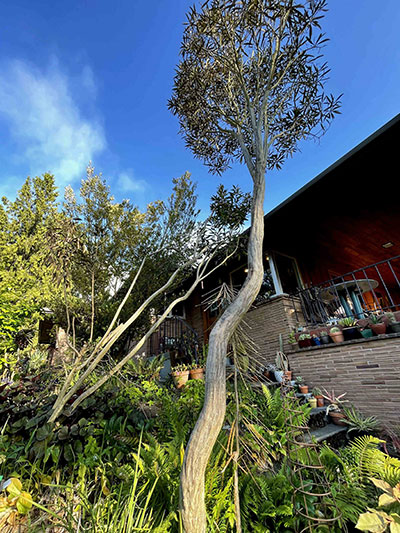
Before signing off for summer break, we’ll have one more segment in mid-June for a final assessment of casualties and survivors from this winter and spring’s protracted chill.
Horticulturally yours,
Daniel
- Panax, meaning “all healing”, is a cognate with “panacea”, referring to the supposed medicinal qualities of the three ginseng species: the East Asian Panax ginseng and P. notoginseng, and the North American P. quinquefolius.
